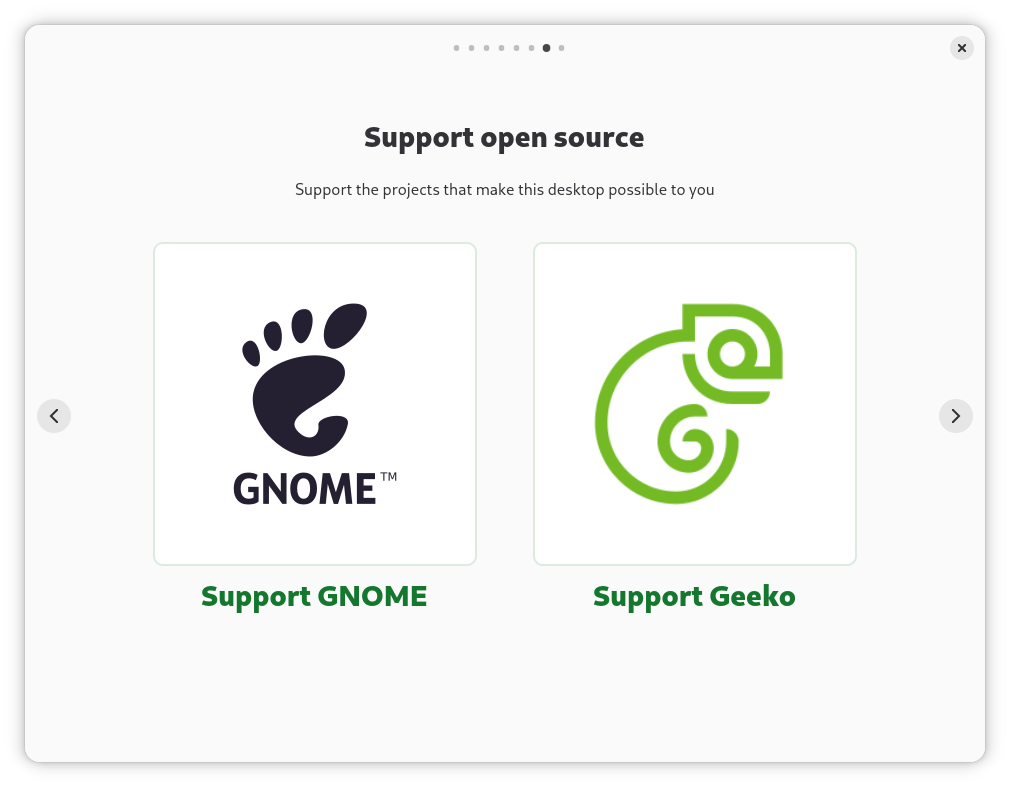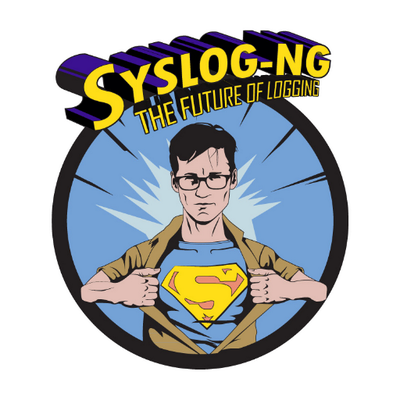

GNOME Tour in openSUSE and welcome app
As a follow up of the Hackweek 24 project, I've continued working on the gnome-tour fork for openSUSE with custom pages to replace the welcome application for openSUSE distributions.
GNOME Tour modifications
All the modifications are on top of upstream gnome-tour and stored in the openSUSE/gnome-tour repo
- Custom initial page

- A new donations page. In openSUSE we remove the popup from GNOME shell for donations, so it's fair to add it in this place.

- Last page with custom openSUSE links, this one is the used for opensuse-welcome app.
opensuse-welcome package
The original opensuse-welcome is a qt application, and this one is used for all desktop environments, but it's more or less unmaintained and looking for a replacement, we can use the gnome-tour fork as the default welcome app for all desktop without a custom app.
To do a minimal desktop agnostic opensuse-welcome application, I've modified the gnome-tour to also generate a second binary but just with the last page.
The new opensuse-welcome rpm package is built as a subpackage of gnome-tour. This new application is minimal and it doesn't have lots of requirements, but as it's a gtk4 application, it requires gtk and libadwaita, and also depends on gnome-tour-data to get the resoures of the app.

To improve this welcome app we need to review the translations, because I added three new pages to the gnome-tour and that specific pages are not translated, so I should regenerate the .po files for all languages and upload to openSUSE Weblate for translations.


Tumbleweed – Review of the week 2025/42
Dear Tumbleweed users and hackers,
If 42 is the answer to the Ultimate Question of Life, the Universe, and Everything, then week 42 of the year 2025 must bring you all the software updates you have waited for your entire life, and your computer has entered the ‘working perfectly mode’ now. The number of snapshots is lower than in other weeks, as openQA ensured we reached perfection and has prevented us from releasing some broken snapshots (broken in the sense that the grub2/snapper integration was denied by SELinux).
We have thus released three snapshots (1013, 1014, and 1015), bringing you these updates:
- KDE Gear 25.08.2
- KDE Frameworks 6.19.0
- Qt 6.10.0
- Linux kernel 6.17.1 & 6.17.2
- GNOME 49.1 (gnome-shell and mutter are pending; they were released a bit later by upstream)
- gimp 3.0.6
- Ruby 3.4.7
- Switch to ffmpeg-8 by default
- LibreOffice 25.8.2.2
- GCC 15.2.1
- Qemu 10.1.1
- libxml 2.14.5
- opensuse-welcome was replaced by opensuse-welcome (sic!): the new implementation is forked off gnome-tour
The outlook for the next week promises to keep going strong. Using OBS’ staging areas, we are currently testing integration of:
- Linux kernel 6.17.3
- Mozilla Firefox 144.0
- KDE Plasma 6.5 (beta 2 being tested; waiting for the final release)
- util-linux 2.41.2
- transactional-update 5.5.0: enables soft-reboot if possible
- Switch from grub2 to grub2-bls
- openSSL 3.6.0: fix for nodejs22 pending


Planet News Roundup
This is a roundup of articles from the openSUSE community listed on planet.opensuse.org.
The below featured highlights listed on the community’s blog feed aggregator are from October 11 to 17.
The week’s Planet highlights an install party at the University of Valencia, KDE Apps of the week, KDE turns 29 and more.
Here is a summary and links for each post:
Morning Day of the XI Annual Conferences of Wikimedia Spain
This blog recounts the author’s experience at the XI Annual Wikimedia Spain Conference in Valencia. Details include exploring the Etno Museum’s setting to attending engaging talks on GLAMWiki and media literacy.
Install party at the University of Valencia October 21
The KDE Blog announces an upcoming install party at the University of Valencia on Oct. 21 as the official support of Windows 10 ends. The association GNU/Linux València invites participants to try out Linux and free software at this hands-on community event.
Matrix Widgets in NeoChat – This Week in KDE Apps
The KDE Blog covers recent KDE app updates, which includes Matrix app NeoChat and social media app Tokodon. The blog also covers enhancements in Dolphin, Kate, Konsole and more.
KDE turns 29
Victorhck and Baltolkien both highlight the KDE’s 29th anniversary and congratulate to the entire community on its journey from the “Kool Desktop Environment” to a thriving global community of developers and users.
Home-made Berliner Currywurst
Perhaps in good taste, Sebastian Kügler shares his recipe for Berlin-style Currywurst, which adds some chili powder to the Linux flavors people can consume on the blog aggregator.
Leap Powers Consultants on the Move
openSUSE News highlights how independent consultants, like Agustín Benito Bethencourt, rely on openSUSE Leap. From meetings to security, Bethencourt highlights a use case that keeps him going while on the move.
DiraQ: Pocket Linux for Quantum Computing
Alessandro de Oliveira Faria introduces DiraQ, which is a a lightweight plug-and-play alternative, that is tailored for quantum computing. It fits a niche use case for research and enthusiasts.
KDE Frameworks 6.19.0
The KDE Blog reports on the latest KDE Frameworks 6.19 version and highlights its bug fixes, and enhanced performance.
Memory Bank: Labels in HTML
This blog post dives into proper use of the <label> element in HTML forms. It points out best practices and pitfalls developers should avoid with labels.
Talk: What is Free Software? in Castellón
The association GNU/Linux València highlights an upcoming public talk in Castellón on Oct. 24 titled “What is Free Software?|” to spread awareness of free software values.
KDE Gear 25.08 Second Update
The KDE Blog covers the second bugfix release of KDE Gear 25.08. The blog focuses on KDE Connect and neochat as well as other KDE applications.
A lot of stability work for Plasma 6.5 – This Week in Plasma
The KDE Blog highlights improvements in Plasma 6.5. It shows where Plasma 6.6.0 is moving with the Breeze icon theme “Send” icon. It also points out fixes with KWin and the fixing of issues that bled apps using XWayland on some screens.
Tumbleweed – Review of the week 2025/42
And last but not least, a new weekly review by Dominique Leuenberger and Victorhck in Spanish, detailing the news that has arrived at the openSUSE Tumbleweed repositories in the last week.
View more blogs or learn to publish your own on planet.opensuse.org.


Home-made Berliner Currywurst
Alhoewel ik een paar weken geleden, na meer dan 27 jaar in Nederland te wonen mijn Duits paspoort heb ingeleverd, zijn er toch een paar dingen uit de Duitse cultuur die een plaats mijn hart zullen blijven hebben (naast lange zinnen met comma’s). Een daarvan is het toppunt van Duitse fast-food menu’s (naast Döner Kebab), good old Currywurst.

Het recept (in het Duits, uiteraard) vind je hier. Tip: voeg een heel klein beetje chilipoeder toe voor wat extra pit. Dat mag van mij wel.


Leap Powers Consultants on the Move
For tech consultants, life happens on the move.
From airport lounges to boardrooms across Europe and beyond, the tool of choice for one tech consultant is Slimbook Executive edition powered by openSUSE Leap; it’s a reliable, secure, and flexible Linux machine that seamlessly adapts to the ever-changing demands of independent consulting.
Freelancer tech consultants like Agustín Benito Bethencourt, who shared his use case of Leap, works with multiple clients in highly regulated industries face unique challenges as each customer enforces its own security policies, communication platforms,and compliance protocols.
What works for one organization might be blocked or noncompliant with another.
Leap’s flexibility allows Bethencourt and his consultant company, toscalix, to adapt quickly. As an independent consultant, Bethencourt needs to use many of the video chat tools available. This includes BigBlueButton and Jitsi through the web, plus Google Meet, Zoom, Teams and Slack.
Bethencourt uses Firefox, Edge and Chromium/Chrome because different corporate tools are necessary.
“Some of these tools, I use them through Flatpaks,” Bethencourt said.
Flatpaks are containerized applications designed to run consistently on any Linux distribution and can be found through Flathub.
The consultant’s workflow goes beyond applications. Different customers impose strict security measures, from encrypted drives and segregated vaults to VPNs tied to specific certificates. The consultant uses Bitwarden as a password manager with separate vaults for each client and it reduces risks of accidental data exposure.
Hardware-level protections also play a role. A patch disables the laptop’s webcam when visiting customer facilities. When charging in airports or on-site, the consultant uses USB data blockers to prevent juice jacking attacks, which is a type of attack that exploits USB cables to secretly transfer data while charging.
Bethencourt explained that compiling the information into a document might streamline interactions with security compliance departments.
“My use case might not be fancy,” he said. But “it shows the flexibility from a professional user’s point of view.”
Stories like this illustrate Leap’s adaptability for diverse environments. With Leap 16’s extended lifecycle and enterprise-grade reliability, professionals can count on this distribution whether they are in the office, in transit or on-site with a client.
Members of the openSUSE Project are trying to showcase how people use openSUSE . If you have a use cases for Leap 16 that you want to share, comment on the project’s mailing list.


Memory Bank: Labels In HTML

What is the right way to label something in HTML?
This came up in something I was working on recently. I always forget the best practices for labeling so I wanted to write this blog post to help me remember… and as a quick reference when I inevitably forget 😉.
Default Accessible Names
Some elements provide a default accessible name that can be used by screen readers to provide a label for a given element. For example in a button the value between the open and close tags is the default accessible name.
<button>this is a close button</button>
Sometimes the default accessible name is inaccurate and a separate label needs to be provided to give users accurate context. In these situations labels can help.
Imagine if the button in the code above needed to have X as its text. This is not very informative to screen reader users and we need a better way to indicate what this button does. There are also many elements that do not have default accessible names, so we may need to provide labels for them as well.
Full post here: https://pureooze.com/blog/posts/2025-10-07-memory-bank-labels-in-html/
Memory Bank: Labels In HTML was originally published in Information & Technology on Medium, where people are continuing the conversation by highlighting and responding to this story.


Tumbleweed – Review of the week 2025/41
Dear Tumbleweed users and hackers,
Week 41 started strong, with daily snapshots released, but unfortunately, we hit some roadblocks by the end of the week. A seemingly harmless rename of a snapper plugin caused quite some havoc in openQA, as SELinux was unaware of that change and consequently, a completely untrusted executable was blocked from messing around with the bootloader. Generally, exactly what we want – except in this case, it was an intentional rename of a file. The change has been retracted for now and will be given back to engineering.
Still, we managed to release five snapshots this week (1003, 1004, 1005, 1006, and 1007), containing these changes:
- GTK 4.20.2
- polkit rules prepared for systemd v258
- SDL 3.2.24
- Rust 1.90
- FreeRDP 3.17.2
- Apparmor 4.1.2
The next snapshots in the making will bring these changes:
- FFMpeg 8 by default
- Linux kernel 6.17.1
- GIMP 3.0.6
- libxml2 2.14.5
- QEmu 10.1.1
- Ruby 3.4.7
- KDE Plasma 6.5 (beta 2 is staged, being tested)
- KDE Gear 25.08.2
- Qt 6.10.0
- GNOME 49.1
- util-linux 2.41.2


Planet News Roundup
This is a roundup of articles from the openSUSE community listed on planet.opensuse.org.
The below featured highlights listed on the community’s blog feed aggregator are from October 4 to 10.
The week’s Planet highlights Akademy 2025 in Berlin, unbricking ESP8266 boards on Linux, openSUSE Leap’s liftoff, the FSF’s 40th anniversary, and more.
Here is a summary and links for each post:
Photo from the Grupo Akademy 2025 Berlin
KDE Blog shares the traditional group photo from Akademy 2025, which was held in Berlin from Sept. 6–11, and captures the spirit, camaraderie, and energy of the community during a week of talks, workshops, and collaboration.
The syslog-ng Insider 2025-10: Values; BastilleBSD; Debian
The October syslog-ng newsletter highlights the project’s core values, running syslog-ng in BastilleBSD, and announces updates to the Debian and Ubuntu blogs.
Cañas Podcast, is Free, Akademy Spain and JPOD in KDE Express 56
KDE Blog highlights KDE Express episode 56, where David Marzal covers upcoming Spanish-speaking free software events like Cañas y Podcast, esLibre, Akademy_ES, and JPOD that highlights the vibrant Spanish-speaking KDE community.
Kwlejka for Plasma. Simply a text area for your desktop
Victorhck introduces Kwlejka, a minimalist KDE Plasma widget, that provides a simple text area on the desktop for storing, pasting, and reusing snippets without needing a dedicated text editor.
Unbricking an ESP8266 with esptool.py on Linux
CubicleNate shares a quick guide on recovering a bricked ESP8266 NodeMCU board using esptool.py on Linux, covering prerequisites, USB permissions, and flashing firmware like WLED.
Mindtrek 2025
Timo Jyrinki reports from Mindtrek 2025 in Tampere, Finland, which is a conference centered on “OpenTech: Towards Digital Sovereignty”; the blog highlights SUSE’s talk on digital sovereignty, and discussions ranging from HPC federation to open source in education.
GSoC 2025, Building a Semantic Search Engine for Any Video
Akash Kumar shares his GSoC 2025 project with openSUSE, which is a semantic video search engine that uses AI models and vector databases to let users search videos by content; it’s not just for titles or tags.
First impressions of the 11th Annual Wikimedia Spain Conference
KDE Blog shares positive first impressions from the 11th Wikimedia España Annual Conference in Valencia, highlighting talks, the organization, and capturing the spirit of the community.
Budapest Audio Expo 2025
Peter Czanik reviews Budapest Audio Expo 2025, praising Hungarian-made audio systems from Dorn/Heed, NCS Audio/Qualiton, and Popori/72 Audio for rivaling global high-end sound at more affordable prices.
KDE Neon is now testing Plasma 6.5 beta 2
KDE Blog reports that KDE neon is now testing Plasma 6.5 Beta 2 and preparing for an Oct. 21 release. The blog encourages users to try the beta and report bugs for a polished final version.
DuckDuckGo search engine donates money to various organizations
Victorhck reports that DuckDuckGo has once again donated funds to organizations worldwide that are supporting privacy, digital rights, open source, and a safer, more democratic internet. The amount donated this year $1.1 million to 30 digital rights and privacy-focused organizations.
openSUSE Leap Ready for Liftoff
openSUSE News highlights community use cases ahead of Leap 16, including aviation tracking with ADS-B receivers, showcasing the distribution’s stability, versatility, and readiness for both hobbyist and enterprise deployments.
First update of KPhotoAlbum 6, adjusting the new version
KDE Blog covers the release of KPhotoAlbum 6.1.0, the first update since its port to Qt6/KF6, which brings new options with usability improvements and bug fixes for the lightweight photo organizer.
The Free Software Foundation turns 40
Victorhck celebrates the 40th anniversary of the Free Software Foundation. The blog piece reflects on its history, core freedoms, global impact, and ongoing campaigns defending users’ digital rights and software freedom.
Plasma 6.5 beta 2 – This week in Plasma
KDE Blog shares a Spanish translation of Nate Graham’s “This Week in Plasma,” covering Plasma 6.5 Beta 2 with major bug fixes, UI improvements, and updates across Plasma, Frameworks, and Discover.
View more blogs or learn to publish your own on planet.opensuse.org.


Request Workflow: Accept & Forward by Default and Clearer History


The syslog-ng Insider 2025-08: Values; BastilleBSD; Debian
The October syslog-ng newsletter is now on-line:
- The core values of syslog-ng
- Running syslog-ng in BastilleBSD
- Debian and Ubuntu blogs updated
It is available at https://www.syslog-ng.com/community/b/blog/posts/the-syslog-ng-insider-2025-10-values-bastillebsd-debian


 Member
Member DimStar
DimStar